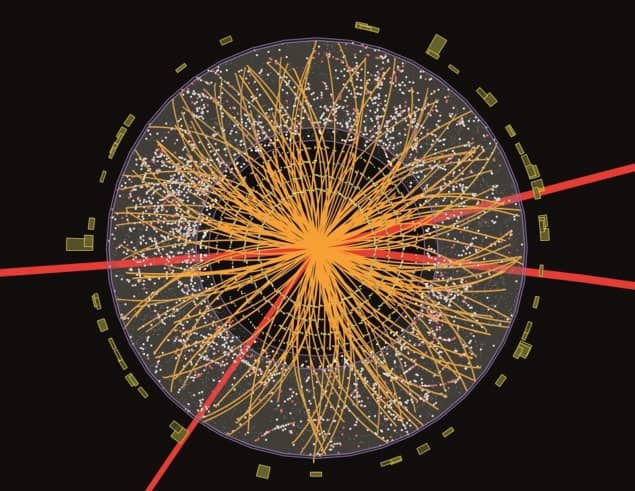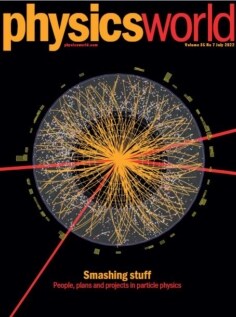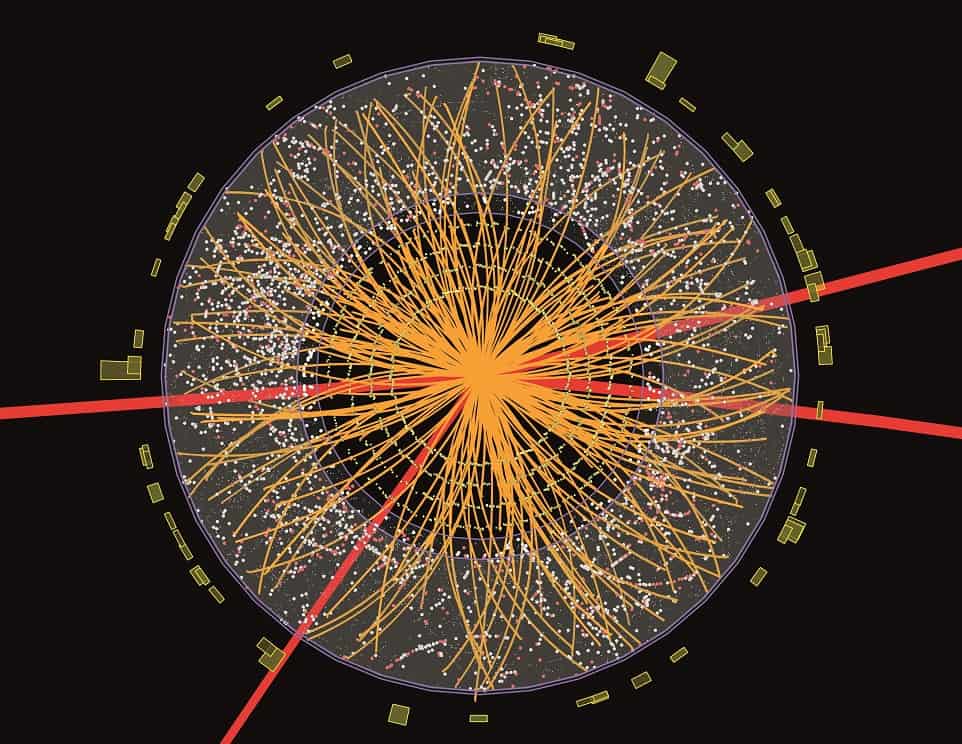The past, present and future of high-energy physics come under the spotlight in the July 2022 special issue of Physics World magazine.

It’s rare in physics to be able to say “I was there” when a great discovery is announced. But several hundred people certainly enjoyed that privilege 10 years ago on 4 July 2012 as they crammed into CERN’s main auditorium. There they heard Joe Incandela and then Fabiola Gianotti – spokespeople for the CMS and ATLAS collaborations respectively – reveal the latest data from the Large Hadron Collider (LHC). The Higgs boson (or at least “a Higgs boson”) had been discovered. “I think we have it,” as CERN boss Rolf Dieter Heuer declared.
But what was astounding for such a technical discussion was that hundreds of thousands of people had tuned in from around the world to witness the event online. Hardcore particle physics had never been so popular, with non-physicists able to listen to discussions of the Standard Model, decay channels and standard deviations.
The announcement was a high-water mark for CERN. Over the previous few years, news about the LHC had been dominated by its early malfunction and scare stories the collider might make tiny – but potentially Earth-destroying – black holes.
Another celebration for high-energy physics that matches the discovery of the Higgs may be a long time coming.
In the July 2022 edition of Physics World magazine, which is now out in print and digital formats, Achintya Rao, who was working as a science communicator for CERN at the time, reveals the story of how the day unfolded for him and others at CERN (you can also read his article online here).
The announcement of the Higgs boson was brilliantly choreographed by CERN, which let CMS and ATLAS take joint credit. In that way, the lab avoided a repeat of the messiness surrounding the discovery of the W and Z bosons 30 years earlier when one collaboration (UA1) hogged the limelight over the other (UA2). There was more good news in 2013 when Peter Higgs and François Englert shared that year’s Nobel Prize for Physics.

Sadly, that early momentum was not sustained. Particle physicists hoped that signs of supersymmetry would be forthcoming but nature has not played ball.
Headlines over the last decade have instead been dominated by astronomy and astrophysics, with the discovery of gravitational waves and the imaging of black holes. A lot rests on the LHC’s Run 3, which is now under way, and on the subsequent conversion of the LHC into the High-Luminosity LHC. That upgrade will boost the machine’s luminosity 10-fold when it comes online in the 2030s.
And yet the future for high-energy physics is uncertain, as Michael Riordan warns in the new issue.
Russia’s invasion of Ukraine will see CERN end its co-operative agreements with Russia. Japan looks unlikely to build the International Linear Collider, while China’s plans for the China Electron Positron Collider may be too ambitious for even this scientific powerhouse.
In the US, Fermilab’s new director Lia Merminga is concentrating on “high-intensity” experiments, after the shutdown of the Tevatron collider, as she explains in an interview with Laura Hiscott.
Another celebration for high-energy physics that matches the discovery of the Higgs may be a long time coming.
For the record, here’s a full rundown of what is in the issue. Remember that if you’re a member of the Institute of Physics, you can read the whole of Physics World magazine every month via our digital apps for iOS, Android and Web browsers. Let us know what you think about the issue on Twitter, Facebook or by e-mailing us at pwld@ioppublishing.org.
• Satellite explains Betelgeuse dimming – Chance observations by a Japanese weather satellite has shed light on the process that led to Betelgeuse’s ‘Great Dimming’ in 2019. Keith Cooper reports
• ITER seeks new boss after Bigot dies – ITER Council searches for a long-term successor to Bernard Bigot as ITER deputy director Eisuke Tada takes over as interim head of the France-based fusion project. Michael Banks reports
• Gaia releases new Milky Way maps – The third data release from the European Space Agency’s Gaia mission is one of the richest sets of published astronomical information, as Michael Banks finds out
• IUPAP: uniting physicists for the last 100 years – Michel Spiro, president of the International Union of Pure and Applied Physics (IUPAP), talks to Laura Hiscott about the organization’s biggest achievements, its centenary celebrations, and its future
• Tracks of my tears – Physics is often viewed as a dispassionate and purely
objective activity. So how, wonders Robert P Crease, do we explain the reaction of Peter Higgs when the boson that bears his name was discovered?

Celebrating the International Year of Glass: the June 2022 issue of Physics World
• Green-sky thinking – The airline industry is emerging from COVID-19 with progress on de-carbonizing air travel, as James McKenzie discovers
• How to become a better supervisor – Rikke Plougmann argues that PhD students can only thrive if their wellbeing – and not just their scientific development – is properly supported
• A day in physics like no other – Achintya Rao recollects the momentous day 10 years ago when CERN announced it had discovered the Higgs boson
• Directing the future of Fermilab – Lia Merminga has just become the seventh director of the Fermi National Accelerator Laboratory in the US. She talks to Laura Hiscott about accelerator science, the future of particle physics and being the first woman to lead this iconic and influential research centre
• Helen Edwards: pioneer of the Tevatron – Helen Edwards was a formidable force in the field of accelerator science, whose impact can still be felt around the world today. Anita Chandran finds out more about her contributions to particle physics
• Making science centre stage – Jim Grozier reviews The Importance of Being Interested: Adventures in Scientific Curiosity by Robin Ince
• The man behind the machine – Achintya Rao reviews Elusive: How Peter Higgs Solved the Mystery of Mass by Frank Close
• On the particle pathway – Experimental physicist Freya Blekman talks to
Tushna Commissariat about the joy of working on big science collaborations
• Keep on keeping on – Exactly a decade after the announcement that the Higgs boson had been found, particle physicist Daniel Whiteson and artist Jorge Cham wonder how we can sustain the excitement of 4 July 2012 and what new particles – if any – might be awaiting discovery
